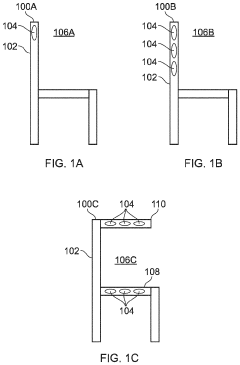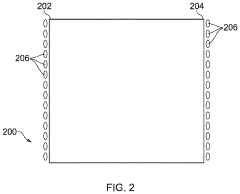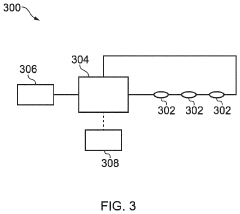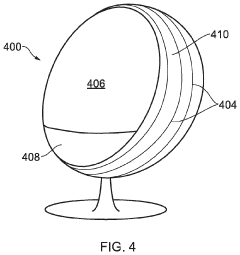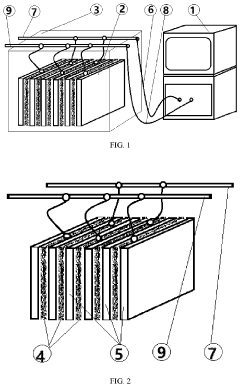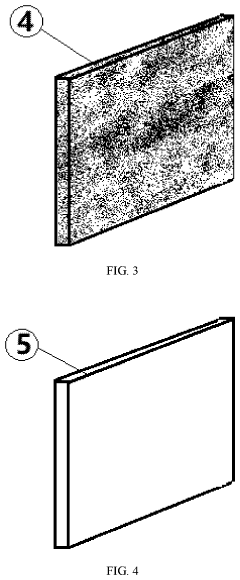How to Monitor Schumann Resonance in Real-Time?
JUN 24, 20259 MIN READ
Generate Your Research Report Instantly with AI Agent
Patsnap Eureka helps you evaluate technical feasibility & market potential.
Schumann Resonance Background and Objectives
Schumann resonances, discovered by physicist Winfried Otto Schumann in 1952, are a set of spectrum peaks in the extremely low frequency (ELF) portion of the Earth's electromagnetic field spectrum. These resonances occur between the Earth's surface and the ionosphere, creating a natural global electromagnetic resonance phenomenon. The fundamental frequency of Schumann resonances is approximately 7.83 Hz, with harmonics at higher frequencies.
The study of Schumann resonances has gained significant attention in recent years due to its potential applications in various fields, including climate monitoring, earthquake prediction, and human health research. Real-time monitoring of Schumann resonances has become increasingly important as it provides valuable insights into global electromagnetic phenomena and their interactions with the Earth's atmosphere and ionosphere.
The primary objective of real-time Schumann resonance monitoring is to develop a robust and accurate system capable of continuously measuring and analyzing these low-frequency electromagnetic waves. This involves overcoming several technical challenges, such as noise reduction, signal processing, and data interpretation. By achieving real-time monitoring capabilities, researchers aim to enhance our understanding of global electromagnetic phenomena and their potential impacts on various Earth systems.
One of the key goals in Schumann resonance monitoring is to improve the spatial and temporal resolution of measurements. This requires the development of advanced sensor technologies and data acquisition systems capable of detecting subtle variations in the electromagnetic field. Additionally, researchers are working towards creating a global network of monitoring stations to provide comprehensive coverage and enable the study of regional variations in Schumann resonances.
Another important objective is to establish standardized protocols for data collection, processing, and analysis. This standardization will facilitate the comparison of results from different monitoring stations and contribute to the creation of a global database of Schumann resonance measurements. Such a database would be invaluable for long-term studies of Earth's electromagnetic environment and its potential correlations with other geophysical phenomena.
As technology continues to advance, there is a growing interest in miniaturizing Schumann resonance monitoring equipment to make it more accessible and deployable in various environments. This includes the development of portable devices that can be used for field measurements and the integration of Schumann resonance sensors into existing environmental monitoring networks.
The study of Schumann resonances has gained significant attention in recent years due to its potential applications in various fields, including climate monitoring, earthquake prediction, and human health research. Real-time monitoring of Schumann resonances has become increasingly important as it provides valuable insights into global electromagnetic phenomena and their interactions with the Earth's atmosphere and ionosphere.
The primary objective of real-time Schumann resonance monitoring is to develop a robust and accurate system capable of continuously measuring and analyzing these low-frequency electromagnetic waves. This involves overcoming several technical challenges, such as noise reduction, signal processing, and data interpretation. By achieving real-time monitoring capabilities, researchers aim to enhance our understanding of global electromagnetic phenomena and their potential impacts on various Earth systems.
One of the key goals in Schumann resonance monitoring is to improve the spatial and temporal resolution of measurements. This requires the development of advanced sensor technologies and data acquisition systems capable of detecting subtle variations in the electromagnetic field. Additionally, researchers are working towards creating a global network of monitoring stations to provide comprehensive coverage and enable the study of regional variations in Schumann resonances.
Another important objective is to establish standardized protocols for data collection, processing, and analysis. This standardization will facilitate the comparison of results from different monitoring stations and contribute to the creation of a global database of Schumann resonance measurements. Such a database would be invaluable for long-term studies of Earth's electromagnetic environment and its potential correlations with other geophysical phenomena.
As technology continues to advance, there is a growing interest in miniaturizing Schumann resonance monitoring equipment to make it more accessible and deployable in various environments. This includes the development of portable devices that can be used for field measurements and the integration of Schumann resonance sensors into existing environmental monitoring networks.
Market Analysis for Real-Time SR Monitoring
The market for real-time Schumann Resonance (SR) monitoring is experiencing significant growth, driven by increasing applications in various fields such as geophysics, climate research, and health sciences. As awareness of the potential impacts of SR on human health and environmental systems grows, the demand for accurate and continuous monitoring solutions is rising.
In the scientific research sector, there is a strong demand for high-precision SR monitoring equipment. Universities and research institutions are investing in advanced monitoring systems to study the relationship between SR and various natural phenomena, including climate change, seismic activity, and ionospheric disturbances. This segment of the market is characterized by a need for highly sensitive instruments capable of detecting minute variations in SR frequencies and amplitudes.
The healthcare industry is emerging as a promising market for SR monitoring devices. Some studies suggest that SR may influence human circadian rhythms and overall well-being. As a result, there is growing interest in developing personal SR monitoring devices for health and wellness applications. This consumer-oriented segment of the market is expected to see rapid growth in the coming years, with potential for wearable devices and smartphone applications.
Environmental monitoring agencies and meteorological organizations represent another significant market segment. These entities require real-time SR data to enhance their understanding of global electromagnetic phenomena and improve weather and climate prediction models. The integration of SR monitoring into existing environmental monitoring networks is likely to drive demand for scalable and easily deployable monitoring solutions.
The aerospace and defense sectors also show interest in SR monitoring for potential applications in communication systems and navigation. As SR can affect radio wave propagation, real-time monitoring could provide valuable data for improving the reliability of long-range communication and navigation systems.
From a geographical perspective, the market for SR monitoring equipment is global, with significant demand in North America, Europe, and Asia-Pacific regions. However, there is potential for market expansion in developing countries, particularly those prone to natural disasters, as SR monitoring could contribute to early warning systems.
The market is currently dominated by specialized scientific instrument manufacturers, but there is room for new entrants, especially in the consumer and IoT device segments. As technology advances and miniaturization becomes possible, we can expect to see more diverse and accessible SR monitoring solutions entering the market.
Overall, the market for real-time SR monitoring is poised for steady growth, driven by scientific curiosity, potential health applications, and the need for improved environmental and geophysical monitoring. The convergence of advanced sensor technologies, data analytics, and increasing awareness of SR's importance is likely to create new opportunities and drive innovation in this niche but expanding market.
In the scientific research sector, there is a strong demand for high-precision SR monitoring equipment. Universities and research institutions are investing in advanced monitoring systems to study the relationship between SR and various natural phenomena, including climate change, seismic activity, and ionospheric disturbances. This segment of the market is characterized by a need for highly sensitive instruments capable of detecting minute variations in SR frequencies and amplitudes.
The healthcare industry is emerging as a promising market for SR monitoring devices. Some studies suggest that SR may influence human circadian rhythms and overall well-being. As a result, there is growing interest in developing personal SR monitoring devices for health and wellness applications. This consumer-oriented segment of the market is expected to see rapid growth in the coming years, with potential for wearable devices and smartphone applications.
Environmental monitoring agencies and meteorological organizations represent another significant market segment. These entities require real-time SR data to enhance their understanding of global electromagnetic phenomena and improve weather and climate prediction models. The integration of SR monitoring into existing environmental monitoring networks is likely to drive demand for scalable and easily deployable monitoring solutions.
The aerospace and defense sectors also show interest in SR monitoring for potential applications in communication systems and navigation. As SR can affect radio wave propagation, real-time monitoring could provide valuable data for improving the reliability of long-range communication and navigation systems.
From a geographical perspective, the market for SR monitoring equipment is global, with significant demand in North America, Europe, and Asia-Pacific regions. However, there is potential for market expansion in developing countries, particularly those prone to natural disasters, as SR monitoring could contribute to early warning systems.
The market is currently dominated by specialized scientific instrument manufacturers, but there is room for new entrants, especially in the consumer and IoT device segments. As technology advances and miniaturization becomes possible, we can expect to see more diverse and accessible SR monitoring solutions entering the market.
Overall, the market for real-time SR monitoring is poised for steady growth, driven by scientific curiosity, potential health applications, and the need for improved environmental and geophysical monitoring. The convergence of advanced sensor technologies, data analytics, and increasing awareness of SR's importance is likely to create new opportunities and drive innovation in this niche but expanding market.
Current Challenges in SR Detection
Real-time monitoring of Schumann Resonance (SR) presents several significant challenges that researchers and engineers must overcome. One of the primary difficulties lies in the extremely low frequency and weak signal strength of SR, typically ranging from 7.83 Hz to 45 Hz. This low-frequency nature requires highly sensitive equipment capable of detecting and isolating these faint signals from background noise.
Environmental interference poses another major obstacle in SR detection. Natural and man-made electromagnetic noise can easily overwhelm the subtle SR signals, necessitating sophisticated filtering techniques and careful site selection for monitoring stations. Urban areas, in particular, are problematic due to the prevalence of electrical infrastructure and electronic devices that generate electromagnetic interference.
The global nature of SR phenomena adds complexity to real-time monitoring efforts. To obtain a comprehensive understanding of SR behavior, a network of geographically distributed monitoring stations is required. Coordinating these stations and ensuring consistent data quality across different locations presents logistical and technical challenges, especially in remote or harsh environments.
Data processing and analysis in real-time constitute another significant hurdle. The vast amount of data generated by continuous SR monitoring necessitates robust computational systems capable of rapid processing and analysis. Developing algorithms that can accurately identify and characterize SR signals amidst noise and variations in real-time is an ongoing challenge for researchers.
The dynamic nature of the Earth's ionosphere further complicates SR detection. Fluctuations in ionospheric conditions due to solar activity, geomagnetic storms, and other atmospheric phenomena can affect SR characteristics. Real-time monitoring systems must be adaptable to these changes and capable of distinguishing between normal variations and anomalous events.
Calibration and standardization of SR monitoring equipment across different research groups and monitoring stations remain challenging. The lack of universally accepted standards for SR measurement and data reporting can lead to discrepancies in results and difficulties in comparing data from various sources.
Lastly, the interdisciplinary nature of SR research presents challenges in integrating knowledge from diverse fields such as atmospheric physics, electrical engineering, and geophysics. Developing a comprehensive understanding of SR behavior and its potential applications requires collaboration across these disciplines, which can be challenging to coordinate and synthesize effectively in real-time monitoring scenarios.
Environmental interference poses another major obstacle in SR detection. Natural and man-made electromagnetic noise can easily overwhelm the subtle SR signals, necessitating sophisticated filtering techniques and careful site selection for monitoring stations. Urban areas, in particular, are problematic due to the prevalence of electrical infrastructure and electronic devices that generate electromagnetic interference.
The global nature of SR phenomena adds complexity to real-time monitoring efforts. To obtain a comprehensive understanding of SR behavior, a network of geographically distributed monitoring stations is required. Coordinating these stations and ensuring consistent data quality across different locations presents logistical and technical challenges, especially in remote or harsh environments.
Data processing and analysis in real-time constitute another significant hurdle. The vast amount of data generated by continuous SR monitoring necessitates robust computational systems capable of rapid processing and analysis. Developing algorithms that can accurately identify and characterize SR signals amidst noise and variations in real-time is an ongoing challenge for researchers.
The dynamic nature of the Earth's ionosphere further complicates SR detection. Fluctuations in ionospheric conditions due to solar activity, geomagnetic storms, and other atmospheric phenomena can affect SR characteristics. Real-time monitoring systems must be adaptable to these changes and capable of distinguishing between normal variations and anomalous events.
Calibration and standardization of SR monitoring equipment across different research groups and monitoring stations remain challenging. The lack of universally accepted standards for SR measurement and data reporting can lead to discrepancies in results and difficulties in comparing data from various sources.
Lastly, the interdisciplinary nature of SR research presents challenges in integrating knowledge from diverse fields such as atmospheric physics, electrical engineering, and geophysics. Developing a comprehensive understanding of SR behavior and its potential applications requires collaboration across these disciplines, which can be challenging to coordinate and synthesize effectively in real-time monitoring scenarios.
Existing Real-Time SR Monitoring Solutions
01 Electromagnetic field detection systems
Systems designed for real-time monitoring of Schumann Resonance often employ electromagnetic field detection techniques. These systems use specialized sensors and equipment to measure and analyze the low-frequency electromagnetic waves associated with Schumann Resonance. The detection systems can be configured to continuously monitor and record changes in the electromagnetic field, providing valuable data for research and analysis.- Electromagnetic field detection systems: Systems designed for real-time monitoring of Schumann Resonance often employ electromagnetic field detection techniques. These systems use specialized sensors and equipment to measure and analyze the low-frequency electromagnetic waves associated with Schumann Resonance. The detection systems may include antennas, amplifiers, and signal processing units to capture and interpret the resonance data accurately.
- Data processing and analysis methods: Real-time monitoring of Schumann Resonance involves sophisticated data processing and analysis methods. These methods may include signal filtering, spectral analysis, and advanced algorithms to extract meaningful information from the raw electromagnetic data. The processing techniques help in identifying and characterizing the various frequency components of Schumann Resonance, enabling researchers to study its variations and potential correlations with other phenomena.
- Network-based monitoring systems: To achieve comprehensive real-time monitoring of Schumann Resonance, network-based systems are often employed. These systems integrate multiple monitoring stations distributed across different geographical locations. The networked approach allows for the collection and comparison of data from various sites, providing a more complete picture of global Schumann Resonance activity. Such systems may utilize cloud computing and data synchronization technologies for efficient data management and analysis.
- Mobile and portable monitoring devices: Advancements in technology have led to the development of mobile and portable devices for Schumann Resonance monitoring. These compact devices allow for on-the-go measurements and can be easily deployed in various environments. They often incorporate miniaturized sensors, battery-powered systems, and wireless communication capabilities to transmit data in real-time to central processing units or cloud-based platforms.
- Applications and integration with other systems: Real-time Schumann Resonance monitoring systems are being integrated with other environmental and geophysical monitoring systems. This integration allows for correlative studies and broader applications in fields such as atmospheric science, geophysics, and potentially health-related research. Some systems also incorporate user interfaces and visualization tools to make the monitored data more accessible and interpretable for researchers and other stakeholders.
02 Data processing and analysis methods
Advanced data processing and analysis methods are crucial for real-time Schumann Resonance monitoring. These methods involve algorithms and software solutions that can quickly process large amounts of electromagnetic data, identify patterns, and extract meaningful information. Real-time analysis techniques enable researchers to detect and interpret changes in Schumann Resonance frequencies and amplitudes as they occur.Expand Specific Solutions03 Network-based monitoring systems
Network-based systems for Schumann Resonance monitoring allow for distributed data collection and centralized analysis. These systems typically involve multiple monitoring stations connected to a central server or cloud-based platform. This approach enables real-time data sharing, collaborative research, and the ability to compare Schumann Resonance measurements from different geographical locations simultaneously.Expand Specific Solutions04 Mobile and portable monitoring devices
Portable and mobile devices for Schumann Resonance monitoring have been developed to enable field measurements and personal use. These compact devices often integrate sensors, data processing capabilities, and wireless connectivity into a single unit. They allow researchers and enthusiasts to conduct real-time Schumann Resonance measurements in various locations and environmental conditions.Expand Specific Solutions05 Integration with health and environmental monitoring
Some Schumann Resonance monitoring systems are designed to integrate with broader health and environmental monitoring applications. These integrated systems can correlate Schumann Resonance data with other environmental factors or physiological measurements. This approach allows researchers to study potential relationships between Schumann Resonance variations and various health or environmental phenomena in real-time.Expand Specific Solutions
Key Players in SR Monitoring Industry
The monitoring of Schumann Resonance in real-time is an emerging field with growing interest across various sectors. The market is in its early growth stage, with increasing applications in geophysics, climate research, and potentially health monitoring. While the market size is still relatively small, it's expanding due to advancements in sensor technology and data processing capabilities. Companies like Schlumberger Technologies, Inc. and Siemens Corp. are leveraging their expertise in sensing technologies to develop more accurate and reliable monitoring systems. Academic institutions such as Zhejiang University and the University of Science & Technology of China are contributing to the technological maturity through research and development of novel detection methods. As the technology matures, we can expect increased collaboration between industry players and research institutions to drive innovation and market growth.
Bar-Ilan University
Technical Solution: Bar-Ilan University has pioneered a unique approach to real-time Schumann Resonance monitoring using a combination of ground-based and satellite-based sensors. Their system employs a network of ground stations equipped with ultra-low noise induction coil magnetometers, coupled with data from satellites measuring the Earth's magnetic field. This dual approach allows for a more comprehensive view of global electromagnetic phenomena. The university has developed proprietary software that combines these data streams and applies advanced spectral analysis techniques to isolate and track Schumann Resonances in real-time. Additionally, they have implemented a novel method for compensating for local electromagnetic interference, enhancing the clarity of the Schumann Resonance signals.
Strengths: Comprehensive global coverage, innovative dual sensor approach, and advanced interference compensation. Weaknesses: Complexity of integrating ground and satellite data, potential for satellite data interruptions.
Zhejiang University
Technical Solution: Zhejiang University has developed an innovative system for real-time Schumann Resonance monitoring using a network of quantum magnetometers. These highly sensitive devices, based on optically pumped magnetometers (OPMs), offer unprecedented precision in detecting weak magnetic fields associated with Schumann Resonances. The university's approach includes a distributed network of these quantum sensors across China, with plans for global expansion. The system incorporates real-time data transmission and processing using edge computing devices at each sensor location, allowing for rapid analysis and noise reduction. A central AI-driven system integrates data from all sensors, providing a comprehensive view of Schumann Resonance activity and its variations over time and space.
Strengths: Extremely high sensitivity and precision, innovative use of quantum technology, and scalable network design. Weaknesses: Currently limited geographical coverage, high cost of quantum sensors, and complexity of maintaining quantum systems in field conditions.
Core Innovations in SR Detection Technology
A magnetic field exposure system and uses thereof
PatentPendingUS20230372726A1
Innovation
- A magnetic field exposure system generating an amplitude-modulated low frequency magnetic field with a carrier frequency of 360 to 450 Hz and a modulation frequency of 0.5 to 100 Hz, providing a field strength of 0.5 to 250 μT, specifically designed to enhance cell survival, proliferation, reduce stress, and promote tissue regeneration.
Carbon allotrope composite field effect artificial aurora generating device
PatentActiveUS20200406223A1
Innovation
- A carbon allotrope composite field effect artificial aurora generating device using foamed nickel or carbon fiber substrates with a carbon allotrope composite, producing high-energy charged particles through Schumann resonance and low-frequency electric fields, which are used to excite auroras and generate active oxygen for pollution reduction.
Environmental Factors Affecting SR Measurements
Environmental factors play a crucial role in the accuracy and reliability of Schumann Resonance (SR) measurements. These factors can significantly influence the quality of data collected and must be carefully considered when designing and implementing real-time monitoring systems.
Electromagnetic interference is one of the primary environmental factors affecting SR measurements. Human-made sources of electromagnetic radiation, such as power lines, radio transmitters, and electronic devices, can introduce noise and distortions into the SR signal. Urban areas are particularly prone to this type of interference, making it challenging to obtain clean SR readings in densely populated regions.
Natural electromagnetic phenomena also impact SR measurements. Solar activity, geomagnetic storms, and lightning strikes can all cause variations in the Earth's electromagnetic field, potentially masking or altering the SR signal. Researchers must account for these natural fluctuations when interpreting SR data and developing monitoring strategies.
Atmospheric conditions, including temperature, humidity, and pressure, can affect the propagation of electromagnetic waves in the Earth-ionosphere cavity. Changes in these parameters can lead to variations in SR frequencies and amplitudes. Seasonal and diurnal cycles may also influence SR measurements, necessitating long-term monitoring to identify and compensate for these patterns.
Geological factors, such as the conductivity of the Earth's surface and subsurface structures, can impact SR propagation and detection. Areas with high mineral content or unique geological formations may experience localized effects on SR measurements. Understanding the geological characteristics of monitoring sites is essential for accurate data interpretation.
The physical location and orientation of SR monitoring equipment can significantly affect measurement quality. Factors such as proximity to conductive structures, elevation, and local topography can influence the strength and clarity of detected SR signals. Careful site selection and equipment placement are critical for obtaining reliable measurements.
Anthropogenic activities, such as industrial operations, transportation, and construction, can generate mechanical vibrations and electromagnetic noise that interfere with SR detection. Monitoring sites should be chosen to minimize exposure to these disturbances, or appropriate shielding and filtering techniques must be employed to mitigate their effects.
Climate change and long-term environmental shifts may also impact SR measurements over extended periods. Changes in global temperature, atmospheric composition, and ionospheric conditions could potentially alter the characteristics of the Earth-ionosphere cavity, affecting SR propagation and detection.
To address these environmental challenges, researchers must employ various strategies, including advanced signal processing techniques, multi-site measurements for cross-validation, and the integration of data from other environmental monitoring systems. Continuous calibration and validation of monitoring equipment are essential to maintain measurement accuracy in the face of changing environmental conditions.
Electromagnetic interference is one of the primary environmental factors affecting SR measurements. Human-made sources of electromagnetic radiation, such as power lines, radio transmitters, and electronic devices, can introduce noise and distortions into the SR signal. Urban areas are particularly prone to this type of interference, making it challenging to obtain clean SR readings in densely populated regions.
Natural electromagnetic phenomena also impact SR measurements. Solar activity, geomagnetic storms, and lightning strikes can all cause variations in the Earth's electromagnetic field, potentially masking or altering the SR signal. Researchers must account for these natural fluctuations when interpreting SR data and developing monitoring strategies.
Atmospheric conditions, including temperature, humidity, and pressure, can affect the propagation of electromagnetic waves in the Earth-ionosphere cavity. Changes in these parameters can lead to variations in SR frequencies and amplitudes. Seasonal and diurnal cycles may also influence SR measurements, necessitating long-term monitoring to identify and compensate for these patterns.
Geological factors, such as the conductivity of the Earth's surface and subsurface structures, can impact SR propagation and detection. Areas with high mineral content or unique geological formations may experience localized effects on SR measurements. Understanding the geological characteristics of monitoring sites is essential for accurate data interpretation.
The physical location and orientation of SR monitoring equipment can significantly affect measurement quality. Factors such as proximity to conductive structures, elevation, and local topography can influence the strength and clarity of detected SR signals. Careful site selection and equipment placement are critical for obtaining reliable measurements.
Anthropogenic activities, such as industrial operations, transportation, and construction, can generate mechanical vibrations and electromagnetic noise that interfere with SR detection. Monitoring sites should be chosen to minimize exposure to these disturbances, or appropriate shielding and filtering techniques must be employed to mitigate their effects.
Climate change and long-term environmental shifts may also impact SR measurements over extended periods. Changes in global temperature, atmospheric composition, and ionospheric conditions could potentially alter the characteristics of the Earth-ionosphere cavity, affecting SR propagation and detection.
To address these environmental challenges, researchers must employ various strategies, including advanced signal processing techniques, multi-site measurements for cross-validation, and the integration of data from other environmental monitoring systems. Continuous calibration and validation of monitoring equipment are essential to maintain measurement accuracy in the face of changing environmental conditions.
Data Processing and Visualization Techniques
Real-time monitoring of Schumann Resonance requires sophisticated data processing and visualization techniques to extract meaningful information from the raw electromagnetic signals. The first step in this process involves signal preprocessing, which includes filtering out noise and unwanted frequencies. This is typically achieved through the application of bandpass filters tuned to the specific frequency range of Schumann Resonances (7.83 Hz and its harmonics).
Once the signal is cleaned, Fast Fourier Transform (FFT) algorithms are employed to convert the time-domain data into the frequency domain. This transformation allows for the identification and analysis of specific frequency components within the Schumann Resonance spectrum. Advanced spectral analysis techniques, such as the Welch method or multitaper spectral estimation, can be used to improve the resolution and reliability of the frequency analysis.
To handle the continuous stream of data in real-time, efficient data management systems are crucial. Time-series databases, such as InfluxDB or TimescaleDB, are well-suited for storing and querying large volumes of time-stamped data. These databases offer optimized performance for time-based queries and aggregations, which are essential for real-time monitoring applications.
Visualization plays a critical role in presenting the processed data in an intuitive and informative manner. Real-time spectrograms are commonly used to display the frequency content of the Schumann Resonance over time. These spectrograms can be generated using libraries such as matplotlib or plotly in Python, or D3.js for web-based applications. Interactive dashboards, created with tools like Grafana or Tableau, allow users to explore the data dynamically, adjusting time ranges and applying various filters on-the-fly.
For more advanced analysis, machine learning algorithms can be integrated into the data processing pipeline. Anomaly detection algorithms, such as Isolation Forests or LSTM-based autoencoders, can be trained to identify unusual patterns in the Schumann Resonance data, potentially indicating geomagnetic disturbances or other phenomena of interest. Additionally, predictive models can be developed to forecast short-term variations in the Schumann Resonance, providing valuable insights for researchers and practitioners in the field.
To ensure real-time performance, distributed computing frameworks like Apache Spark or Dask can be utilized to parallelize data processing tasks across multiple nodes. This approach enables the system to handle high data throughput and perform complex computations with minimal latency, which is essential for maintaining up-to-date monitoring of Schumann Resonance.
Once the signal is cleaned, Fast Fourier Transform (FFT) algorithms are employed to convert the time-domain data into the frequency domain. This transformation allows for the identification and analysis of specific frequency components within the Schumann Resonance spectrum. Advanced spectral analysis techniques, such as the Welch method or multitaper spectral estimation, can be used to improve the resolution and reliability of the frequency analysis.
To handle the continuous stream of data in real-time, efficient data management systems are crucial. Time-series databases, such as InfluxDB or TimescaleDB, are well-suited for storing and querying large volumes of time-stamped data. These databases offer optimized performance for time-based queries and aggregations, which are essential for real-time monitoring applications.
Visualization plays a critical role in presenting the processed data in an intuitive and informative manner. Real-time spectrograms are commonly used to display the frequency content of the Schumann Resonance over time. These spectrograms can be generated using libraries such as matplotlib or plotly in Python, or D3.js for web-based applications. Interactive dashboards, created with tools like Grafana or Tableau, allow users to explore the data dynamically, adjusting time ranges and applying various filters on-the-fly.
For more advanced analysis, machine learning algorithms can be integrated into the data processing pipeline. Anomaly detection algorithms, such as Isolation Forests or LSTM-based autoencoders, can be trained to identify unusual patterns in the Schumann Resonance data, potentially indicating geomagnetic disturbances or other phenomena of interest. Additionally, predictive models can be developed to forecast short-term variations in the Schumann Resonance, providing valuable insights for researchers and practitioners in the field.
To ensure real-time performance, distributed computing frameworks like Apache Spark or Dask can be utilized to parallelize data processing tasks across multiple nodes. This approach enables the system to handle high data throughput and perform complex computations with minimal latency, which is essential for maintaining up-to-date monitoring of Schumann Resonance.
Unlock deeper insights with Patsnap Eureka Quick Research — get a full tech report to explore trends and direct your research. Try now!
Generate Your Research Report Instantly with AI Agent
Supercharge your innovation with Patsnap Eureka AI Agent Platform!
